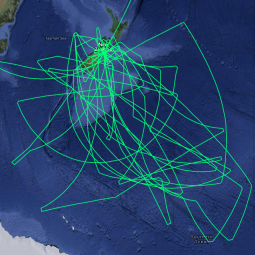NASA's Stratospheric Observatory for Infrared Astronomy (SOFIA) has returned from a six-week deployment to study portions of the universe visible only from Earth's Southern Hemisphere. The flying observatory was based at the National Science Foundation's U.S. Antarctic Program facility at Christchurch International Airport from June 15 to July 24.
"This year's deployment to New Zealand was hugely successful," said SOFIA Program Manager Eddie Zavala. "The quality of the astronomical observing conditions in that part of the world is truly exceptional. I expect that there will be numerous science publications once the data have been processed and analyzed."
SOFIA flies above 99 percent of the Earth’s atmospheric water vapor that blocks infrared radiation from reaching the ground. The quality of the data is further improved by the fact that the remaining thin layer of water vapor above SOFIA during flight is exceptionally dry at this time of the year over the southern ocean. However, obtaining science during winter in the Southern Hemisphere is not without its challenges as winter storms in the area forced several planned observing flights to be cancelled.
To capture data on celestial objects in the southern skies, SOFIA employed an ensemble of four scientific instruments. The Faint Object infraRed CAmera for the SOFIA Telescope (FORCAST – a mid-infrared wavelength camera) led off the first half of the observing period and the German Receiver for Astronomy at Terahertz Frequencies (GREAT – a dual-channel spectrometer) was on the telescope for most of the second half.
In the middle of the deployment, the "FLIPO" instrument configuration was used to observe the dwarf planet Pluto as it passed in front of a distant star, an event known as an "occultation." FLIPO is a merge of acronyms representing the co-mounted Faint Object InfraRed CAmera for the SOFIA Telescope (FLITECAM) and the High-speed Imaging Photometer for Occultations (HIPO) co-mounted on the telescope. FLIPO plus another sensitive camera, the Focal Plane Imager-Plus (FPI+), were carried by SOFIA to the precise position required to capture atmospheric data as Pluto blocked the star's light. “Everyone on the team did their part to make sure that SOFIA was in the right place at the right time. A bright spike of light in the middle of the shadow cast by Pluto was detected as the star's light briefly lit up the dwarf planet’s entire atmosphere. This not only confirmed that SOFIA’s location was nearly perfect, but also provided detailed information about Pluto’s atmosphere in a way that just observing shadow would not,” said SOFIA Project Scientist Pamela Marcum.
“The ability to change which science instruments flew on SOFIA during the deployment following the occultation is significant," Marcum said. "In particular, the FORCAST camera with its spectroscopic capabilities and the GREAT instrument enabled astronomers to make detailed studies of star formation processes in the rich southern Milky Way, the Galactic Center, and the Magellanic Clouds."
SOFIA has returned to its home base at the Armstrong Flight Research Center's facility in Palmdale, California, and after a series of software upgrades will resume flights on August 26. Science data collected during the deployment have been transferred to the SOFIA Science Center at NASA Ames Research Center in Moffett Field, California, for processing and distribution to the principal investigators and their teams.
Points of Contact
Nicholas A. Veronico
SOFIA Science Center, NASA Ames Research Center, Moffett Field, Calif.
650-224-8726
nicholas.a.veronico@nasa.gov
/
nveronico@sofia.usra.edu
Kate K. Squires
Armstrong Flight Research Center, Edwards, Calif.
661-276-2020
kate.k.squires@nasa.gov
